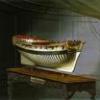-
Posts
596 -
Joined
-
Last visited
Reputation Activity
-
 Dziadeczek got a reaction from Jolley Roger in Is there a Boudriot's 74 Gun Ship in "kit" form???
Dziadeczek got a reaction from Jolley Roger in Is there a Boudriot's 74 Gun Ship in "kit" form???
Hi Michael,
I am scratchbuilding this exact model in the same 1:48 scale, following the books by J. Boudriot.
It is a BIIIG puppy! If you want me to send you exact dimentions, I willl do it. Suffice it to say now, you would absolutely neccesarily need a separate space (a workshop of some kind) to build it. Kitchen table will not do it!!! And prepare yourself for YEARS of work!
If you want to build it exactly like the books describe it, it is a monumental task! But, it is doable, especially now that the addendum (all frame profiles and the keel) is available from Ancre. When I started to build it, this addendum was not available, so I had to hand draw all missing profiles, since Boudriot only shows the so called, station frames (every 4th). It took a long time to draw all of them by hand, since I did not own a computer program.
There is LOOOOTS of wood cutting, sanding and glueing, so several power tools are a must!
Right now I am approaching the running rigging stage and sewing sails from thin muslin. Here is a handful of randomly selected pics of this model.
Regards,
Thomas
-
 Dziadeczek got a reaction from Mark P in Waterways
Dziadeczek got a reaction from Mark P in Waterways
This is how it looks like on the Polish sailing ship "Dar Młodzieży" (Gift of the Youth) - the green area on the right.
-
 Dziadeczek got a reaction from kuya in Would like help identifying clamp and suggestions where I might buy some
Dziadeczek got a reaction from kuya in Would like help identifying clamp and suggestions where I might buy some
I once made a handful of such mini C clamps from a length of aluminium U channel, slicing it on my Preac saw into narrow sections, drilling holes and thread tapping them to match my screws. Mine have 1/2 inch throat size, but perhaps you could also find your size in a hardware store.
These are not heavy duty, plenty of power to hold planks, though.
-
 Dziadeczek got a reaction from mtaylor in Waterways
Dziadeczek got a reaction from mtaylor in Waterways
This is how it looks like on the Polish sailing ship "Dar Młodzieży" (Gift of the Youth) - the green area on the right.
-
 Dziadeczek got a reaction from jud in Waterways
Dziadeczek got a reaction from jud in Waterways
This is how it looks like on the Polish sailing ship "Dar Młodzieży" (Gift of the Youth) - the green area on the right.
-
 Dziadeczek got a reaction from Harvey Golden in Waterways
Dziadeczek got a reaction from Harvey Golden in Waterways
This is how it looks like on the Polish sailing ship "Dar Młodzieży" (Gift of the Youth) - the green area on the right.
-
 Dziadeczek got a reaction from WalrusGuy in Waterways
Dziadeczek got a reaction from WalrusGuy in Waterways
This is how it looks like on the Polish sailing ship "Dar Młodzieży" (Gift of the Youth) - the green area on the right.
-
 Dziadeczek reacted to Jeronimo in French 18-pdr Naval Cannon 1779 by Jeronimo - FINISHED
Dziadeczek reacted to Jeronimo in French 18-pdr Naval Cannon 1779 by Jeronimo - FINISHED
74 GunShip
New - and Reconstruction of the section of the second gun deck.
The cannon stayed the same, only the locking of the cannon barrel / mount (Lafette) was changed.
Karl
(Google Translator)
-
 Dziadeczek got a reaction from Obormotov in Harold Hahn method
Dziadeczek got a reaction from Obormotov in Harold Hahn method
Years ago I built my French 74 gun ship upside down, mounted in H. Hahn's building base, following his method (sort of). I remember, I had to add (draw) the remaining frames, since J. Boudriot only has shown in his books the so called, station frames. The hull turned out OK, not perfect though, but - for the first scratch built, Admiralty type model, - acceptable.
Right now I am starting to install the running rigging on it.
Thomas
-
 Dziadeczek got a reaction from scrubbyj427 in Is there a Boudriot's 74 Gun Ship in "kit" form???
Dziadeczek got a reaction from scrubbyj427 in Is there a Boudriot's 74 Gun Ship in "kit" form???
Hi Michael,
I am scratchbuilding this exact model in the same 1:48 scale, following the books by J. Boudriot.
It is a BIIIG puppy! If you want me to send you exact dimentions, I willl do it. Suffice it to say now, you would absolutely neccesarily need a separate space (a workshop of some kind) to build it. Kitchen table will not do it!!! And prepare yourself for YEARS of work!
If you want to build it exactly like the books describe it, it is a monumental task! But, it is doable, especially now that the addendum (all frame profiles and the keel) is available from Ancre. When I started to build it, this addendum was not available, so I had to hand draw all missing profiles, since Boudriot only shows the so called, station frames (every 4th). It took a long time to draw all of them by hand, since I did not own a computer program.
There is LOOOOTS of wood cutting, sanding and glueing, so several power tools are a must!
Right now I am approaching the running rigging stage and sewing sails from thin muslin. Here is a handful of randomly selected pics of this model.
Regards,
Thomas
-
 Dziadeczek got a reaction from mtaylor in Le Gros Ventre by marsalv - FINISHED - 1:48 - POF
Dziadeczek got a reaction from mtaylor in Le Gros Ventre by marsalv - FINISHED - 1:48 - POF
Wow! Attention to detail is unbelieveable!
Very inspirational! Thanks!
-
 Dziadeczek got a reaction from No Idea in Le Gros Ventre by marsalv - FINISHED - 1:48 - POF
Dziadeczek got a reaction from No Idea in Le Gros Ventre by marsalv - FINISHED - 1:48 - POF
Wow! Attention to detail is unbelieveable!
Very inspirational! Thanks!
-
 Dziadeczek reacted to marsalv in Le Gros Ventre by marsalv - FINISHED - 1:48 - POF
Dziadeczek reacted to marsalv in Le Gros Ventre by marsalv - FINISHED - 1:48 - POF
Thank you guys for nice comments and likes.
I continue with ensign staff.
-
 Dziadeczek reacted to ccoyle in Supermarine Spitfire Mk Vb by ccoyle - FINISHED - Halinski - 1/33 - CARD - aircraft flown by Jan Zumbach as commander of No. 303 Squadron RAF 1942
Dziadeczek reacted to ccoyle in Supermarine Spitfire Mk Vb by ccoyle - FINISHED - Halinski - 1/33 - CARD - aircraft flown by Jan Zumbach as commander of No. 303 Squadron RAF 1942
Ch. 21 Wing, Pt. V: Fillets
As the chapter title suggests, wing fillets are done. These are always fiddly, because they curve in three different directions, so it's a relief when they are finished and haven't turned out too badly. The small port in the wing root is where the gun camera is located, and yes, the kit has separate parts for a gun camera, albeit a very simplified one -- never did a kit with a gun camera before.
-
 Dziadeczek got a reaction from Kurt Bainum in Is there a Boudriot's 74 Gun Ship in "kit" form???
Dziadeczek got a reaction from Kurt Bainum in Is there a Boudriot's 74 Gun Ship in "kit" form???
Hi Michael,
I am scratchbuilding this exact model in the same 1:48 scale, following the books by J. Boudriot.
It is a BIIIG puppy! If you want me to send you exact dimentions, I willl do it. Suffice it to say now, you would absolutely neccesarily need a separate space (a workshop of some kind) to build it. Kitchen table will not do it!!! And prepare yourself for YEARS of work!
If you want to build it exactly like the books describe it, it is a monumental task! But, it is doable, especially now that the addendum (all frame profiles and the keel) is available from Ancre. When I started to build it, this addendum was not available, so I had to hand draw all missing profiles, since Boudriot only shows the so called, station frames (every 4th). It took a long time to draw all of them by hand, since I did not own a computer program.
There is LOOOOTS of wood cutting, sanding and glueing, so several power tools are a must!
Right now I am approaching the running rigging stage and sewing sails from thin muslin. Here is a handful of randomly selected pics of this model.
Regards,
Thomas
-
 Dziadeczek got a reaction from Snug Harbor Johnny in Is there a Boudriot's 74 Gun Ship in "kit" form???
Dziadeczek got a reaction from Snug Harbor Johnny in Is there a Boudriot's 74 Gun Ship in "kit" form???
Hi Michael,
I am scratchbuilding this exact model in the same 1:48 scale, following the books by J. Boudriot.
It is a BIIIG puppy! If you want me to send you exact dimentions, I willl do it. Suffice it to say now, you would absolutely neccesarily need a separate space (a workshop of some kind) to build it. Kitchen table will not do it!!! And prepare yourself for YEARS of work!
If you want to build it exactly like the books describe it, it is a monumental task! But, it is doable, especially now that the addendum (all frame profiles and the keel) is available from Ancre. When I started to build it, this addendum was not available, so I had to hand draw all missing profiles, since Boudriot only shows the so called, station frames (every 4th). It took a long time to draw all of them by hand, since I did not own a computer program.
There is LOOOOTS of wood cutting, sanding and glueing, so several power tools are a must!
Right now I am approaching the running rigging stage and sewing sails from thin muslin. Here is a handful of randomly selected pics of this model.
Regards,
Thomas
-
 Dziadeczek got a reaction from Captain Poison in Is there a Boudriot's 74 Gun Ship in "kit" form???
Dziadeczek got a reaction from Captain Poison in Is there a Boudriot's 74 Gun Ship in "kit" form???
Hi Michael,
I am scratchbuilding this exact model in the same 1:48 scale, following the books by J. Boudriot.
It is a BIIIG puppy! If you want me to send you exact dimentions, I willl do it. Suffice it to say now, you would absolutely neccesarily need a separate space (a workshop of some kind) to build it. Kitchen table will not do it!!! And prepare yourself for YEARS of work!
If you want to build it exactly like the books describe it, it is a monumental task! But, it is doable, especially now that the addendum (all frame profiles and the keel) is available from Ancre. When I started to build it, this addendum was not available, so I had to hand draw all missing profiles, since Boudriot only shows the so called, station frames (every 4th). It took a long time to draw all of them by hand, since I did not own a computer program.
There is LOOOOTS of wood cutting, sanding and glueing, so several power tools are a must!
Right now I am approaching the running rigging stage and sewing sails from thin muslin. Here is a handful of randomly selected pics of this model.
Regards,
Thomas
-
 Dziadeczek got a reaction from Canute in Is there a Boudriot's 74 Gun Ship in "kit" form???
Dziadeczek got a reaction from Canute in Is there a Boudriot's 74 Gun Ship in "kit" form???
Hi Michael,
I am scratchbuilding this exact model in the same 1:48 scale, following the books by J. Boudriot.
It is a BIIIG puppy! If you want me to send you exact dimentions, I willl do it. Suffice it to say now, you would absolutely neccesarily need a separate space (a workshop of some kind) to build it. Kitchen table will not do it!!! And prepare yourself for YEARS of work!
If you want to build it exactly like the books describe it, it is a monumental task! But, it is doable, especially now that the addendum (all frame profiles and the keel) is available from Ancre. When I started to build it, this addendum was not available, so I had to hand draw all missing profiles, since Boudriot only shows the so called, station frames (every 4th). It took a long time to draw all of them by hand, since I did not own a computer program.
There is LOOOOTS of wood cutting, sanding and glueing, so several power tools are a must!
Right now I am approaching the running rigging stage and sewing sails from thin muslin. Here is a handful of randomly selected pics of this model.
Regards,
Thomas
-
 Dziadeczek got a reaction from JpR62 in Is there a Boudriot's 74 Gun Ship in "kit" form???
Dziadeczek got a reaction from JpR62 in Is there a Boudriot's 74 Gun Ship in "kit" form???
Hi Michael,
I am scratchbuilding this exact model in the same 1:48 scale, following the books by J. Boudriot.
It is a BIIIG puppy! If you want me to send you exact dimentions, I willl do it. Suffice it to say now, you would absolutely neccesarily need a separate space (a workshop of some kind) to build it. Kitchen table will not do it!!! And prepare yourself for YEARS of work!
If you want to build it exactly like the books describe it, it is a monumental task! But, it is doable, especially now that the addendum (all frame profiles and the keel) is available from Ancre. When I started to build it, this addendum was not available, so I had to hand draw all missing profiles, since Boudriot only shows the so called, station frames (every 4th). It took a long time to draw all of them by hand, since I did not own a computer program.
There is LOOOOTS of wood cutting, sanding and glueing, so several power tools are a must!
Right now I am approaching the running rigging stage and sewing sails from thin muslin. Here is a handful of randomly selected pics of this model.
Regards,
Thomas
-
 Dziadeczek got a reaction from oneslim in Is there a Boudriot's 74 Gun Ship in "kit" form???
Dziadeczek got a reaction from oneslim in Is there a Boudriot's 74 Gun Ship in "kit" form???
Hi Michael,
I am scratchbuilding this exact model in the same 1:48 scale, following the books by J. Boudriot.
It is a BIIIG puppy! If you want me to send you exact dimentions, I willl do it. Suffice it to say now, you would absolutely neccesarily need a separate space (a workshop of some kind) to build it. Kitchen table will not do it!!! And prepare yourself for YEARS of work!
If you want to build it exactly like the books describe it, it is a monumental task! But, it is doable, especially now that the addendum (all frame profiles and the keel) is available from Ancre. When I started to build it, this addendum was not available, so I had to hand draw all missing profiles, since Boudriot only shows the so called, station frames (every 4th). It took a long time to draw all of them by hand, since I did not own a computer program.
There is LOOOOTS of wood cutting, sanding and glueing, so several power tools are a must!
Right now I am approaching the running rigging stage and sewing sails from thin muslin. Here is a handful of randomly selected pics of this model.
Regards,
Thomas
-
 Dziadeczek got a reaction from GrandpaPhil in Is there a Boudriot's 74 Gun Ship in "kit" form???
Dziadeczek got a reaction from GrandpaPhil in Is there a Boudriot's 74 Gun Ship in "kit" form???
Hi Michael,
I am scratchbuilding this exact model in the same 1:48 scale, following the books by J. Boudriot.
It is a BIIIG puppy! If you want me to send you exact dimentions, I willl do it. Suffice it to say now, you would absolutely neccesarily need a separate space (a workshop of some kind) to build it. Kitchen table will not do it!!! And prepare yourself for YEARS of work!
If you want to build it exactly like the books describe it, it is a monumental task! But, it is doable, especially now that the addendum (all frame profiles and the keel) is available from Ancre. When I started to build it, this addendum was not available, so I had to hand draw all missing profiles, since Boudriot only shows the so called, station frames (every 4th). It took a long time to draw all of them by hand, since I did not own a computer program.
There is LOOOOTS of wood cutting, sanding and glueing, so several power tools are a must!
Right now I am approaching the running rigging stage and sewing sails from thin muslin. Here is a handful of randomly selected pics of this model.
Regards,
Thomas
-
 Dziadeczek got a reaction from Ryland Craze in Is there a Boudriot's 74 Gun Ship in "kit" form???
Dziadeczek got a reaction from Ryland Craze in Is there a Boudriot's 74 Gun Ship in "kit" form???
Hi Michael,
I am scratchbuilding this exact model in the same 1:48 scale, following the books by J. Boudriot.
It is a BIIIG puppy! If you want me to send you exact dimentions, I willl do it. Suffice it to say now, you would absolutely neccesarily need a separate space (a workshop of some kind) to build it. Kitchen table will not do it!!! And prepare yourself for YEARS of work!
If you want to build it exactly like the books describe it, it is a monumental task! But, it is doable, especially now that the addendum (all frame profiles and the keel) is available from Ancre. When I started to build it, this addendum was not available, so I had to hand draw all missing profiles, since Boudriot only shows the so called, station frames (every 4th). It took a long time to draw all of them by hand, since I did not own a computer program.
There is LOOOOTS of wood cutting, sanding and glueing, so several power tools are a must!
Right now I am approaching the running rigging stage and sewing sails from thin muslin. Here is a handful of randomly selected pics of this model.
Regards,
Thomas
-
 Dziadeczek got a reaction from mtaylor in Is there a Boudriot's 74 Gun Ship in "kit" form???
Dziadeczek got a reaction from mtaylor in Is there a Boudriot's 74 Gun Ship in "kit" form???
Hi Michael,
I am scratchbuilding this exact model in the same 1:48 scale, following the books by J. Boudriot.
It is a BIIIG puppy! If you want me to send you exact dimentions, I willl do it. Suffice it to say now, you would absolutely neccesarily need a separate space (a workshop of some kind) to build it. Kitchen table will not do it!!! And prepare yourself for YEARS of work!
If you want to build it exactly like the books describe it, it is a monumental task! But, it is doable, especially now that the addendum (all frame profiles and the keel) is available from Ancre. When I started to build it, this addendum was not available, so I had to hand draw all missing profiles, since Boudriot only shows the so called, station frames (every 4th). It took a long time to draw all of them by hand, since I did not own a computer program.
There is LOOOOTS of wood cutting, sanding and glueing, so several power tools are a must!
Right now I am approaching the running rigging stage and sewing sails from thin muslin. Here is a handful of randomly selected pics of this model.
Regards,
Thomas
-
 Dziadeczek got a reaction from WalrusGuy in Is there a Boudriot's 74 Gun Ship in "kit" form???
Dziadeczek got a reaction from WalrusGuy in Is there a Boudriot's 74 Gun Ship in "kit" form???
Hi Michael,
I am scratchbuilding this exact model in the same 1:48 scale, following the books by J. Boudriot.
It is a BIIIG puppy! If you want me to send you exact dimentions, I willl do it. Suffice it to say now, you would absolutely neccesarily need a separate space (a workshop of some kind) to build it. Kitchen table will not do it!!! And prepare yourself for YEARS of work!
If you want to build it exactly like the books describe it, it is a monumental task! But, it is doable, especially now that the addendum (all frame profiles and the keel) is available from Ancre. When I started to build it, this addendum was not available, so I had to hand draw all missing profiles, since Boudriot only shows the so called, station frames (every 4th). It took a long time to draw all of them by hand, since I did not own a computer program.
There is LOOOOTS of wood cutting, sanding and glueing, so several power tools are a must!
Right now I am approaching the running rigging stage and sewing sails from thin muslin. Here is a handful of randomly selected pics of this model.
Regards,
Thomas
-
 Dziadeczek got a reaction from mtaylor in HMS Victory by ronald305 - Model Space
Dziadeczek got a reaction from mtaylor in HMS Victory by ronald305 - Model Space
Ronald,
Check it out, what Gebhard Kammerlander does with wet wood strips and a hot soldering iron.
The video is rather old and not the best quality, and in German, but you can see what is possible with this technique and what is not.
You do not have to use his electric plank bender, just a regular soldering iron should suffice (with a heat control, if possible, not to burn the wood).
Besides, the degree of wood bending also depends on wood species your planks are made of. Some wood is quite brittle, some very stiff and springly and some very pliable (pear, and somewhat stiffer cherry). The thinner the plank is, the more you can bend it, all the way up to 360 degrees!
Pre wet your planks in luke warm water for 5 - 10 minutes and, while they are wet, heat bend them to a desired curve. Sometimes you have to do it in stages, wetting them and bending, and so on. If you overbend your wood, you can unbend it - using the same technique.
Your planks look rather brittle, I don't know the wood specie (perhaps mahogany?), but you might try to replace them with some fruitwood and heat bend them, instead of using the planks supplied in the kit.
Good luck!
Thomas









.thumb.jpg.62d1d69fed1f32364417cb1f9cdeb009.jpg)








